A Swedish couple have taken a novel approach to keeping their property in Stockholm warm all year round. Marie Granmar and Charles Sacilotto wanted to create a sustainable home in which their family would be comfortable during the long nordic winter, which begins in early October and continues well into April. In order to stay cosy, they constructed a greenhouse around their simple summer home!
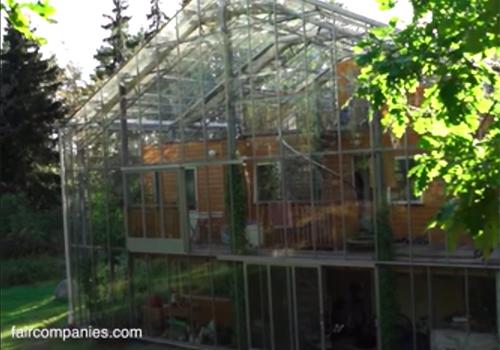
Related: How Does This Man Grow Oranges in Nebraska’s Cold Winter?
The Naturhus Concept.
Where did this ingenious idea come from? Marie and Charles took their inspiration from the Swedish architect Bengt Warne who constructed the first “Naturhus” (Nature House) in Stockholm in 1974. There are a small number of these homes that have been built in Germany and Scandinavia.
Originally, Charles had been intending to find an empty lot and build a Naturhus from scratch. In the end, he found that extending an already existing summer house was the most affordable option, and from this point he followed Warne’s design for the glass exterior. The modest wooden summer house is literally wrapped within a greenhouse! The greenhouse itself is constructed from durable 0.15 inch security glass, designed to withstand usual levels of damage.
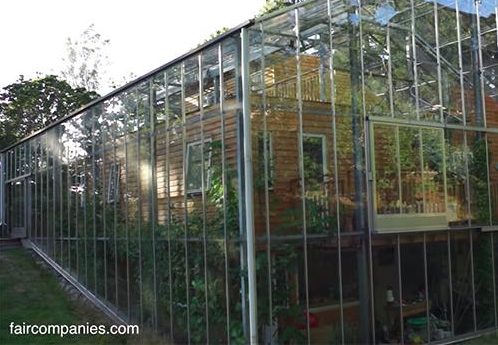
An Adaptable, Light-Filled Home.
The glass construction around the wooden summer house allows them to enjoy their beautiful ‘outdoor’ terrace no matter what the weather. They actually removed a part of the roof of the original house in order to create a larger area for play, rest and relaxation. They have a swing and a basketball hoop set up for their young children, and there is even enough space for the boys to ride their bicycles!
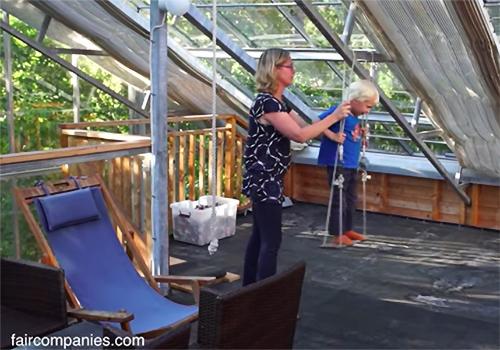
Marie speaks enthusiastically about how the greenhouse protects them from wind, rain and storms as well as keeping the cold at bay. She says that they no longer suffer from the ‘bad weather blues’ in the way that many of her neighbors do. As the interior house is so well protected from the elements, they only need to treat the wood construction with with a layer of natural linseed oil, avoiding the use of any chemical products.
Natural Temperature Regulation.
The solar energy that the house captures means that there was no need to install thick insulation, as is common practice in Sweden. As well as this, the family are no longer dependent on excessive, energy-consuming heating. They have their own store of wood and a simple wood-burning stove to provide additional heat on the very coldest winter days. Marie says that they take a “realistic” approach, and expect to put on warmer clothes on colder days, understanding that their natural home will have some natural temperature fluctuations.
Related: How to Build Your Own Solar Panels
Charles talks about how the house heats up effectively with just an hour of sunlight, and in January when outdoor temperatures can be below 32°F, their home within the glass is a comfy 59°F-68°F. In the warmer months, the glass roof has an automatic opening which releases heat when the atmosphere goes above a certain temperature. Balcony doors and windows can also be opened by hand to get the air flowing, making the house adaptable to the demands of summer too.
A Bountiful Home Harvest.
The footprint of the greenhouse is nearly double the size of the interior home, which gives plenty of space for a beautiful wrap-around garden. This allows them to make use of the greenhouse’s traditional function – that of growing plants. Charles and Marie are able to cultivate crops that would otherwise be impossible in the cool Swedish climate. They enjoy regular harvests of grapes and figs, as well as being able to extend their vegetable growing season and have success with heat-loving crops such as cucumbers and tomatoes.
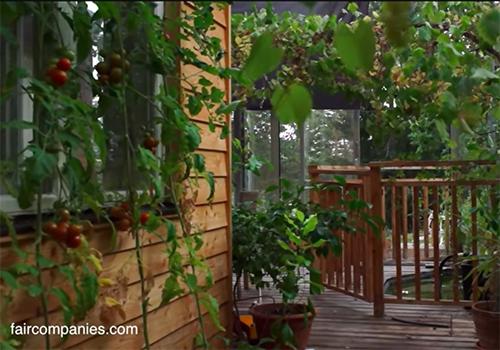
A Self-Sufficient Approach.
On top of enjoying the free heat of the sun, the family have an underground rain-water catching tank that provides water for their plants. The plants also benefit from a clever composting system. Charles is an engineer by training, so the family have urine separating toilets connected to a completely natural, home-designed system with various tanks as well as gray water beds that filter and clean their waste and provide a fertile home for more plants. An outdoor pond provides a final resting place for any residues that can’t be used within the home, and this also provides extra nourishment for some fruit trees.
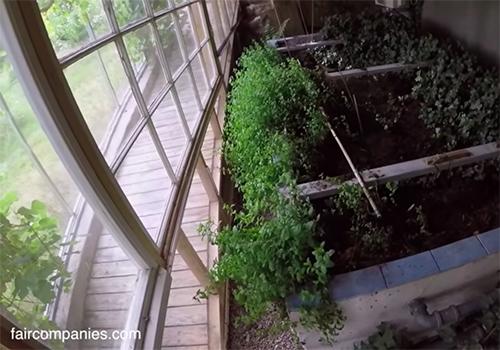
In the future, Marie and Charles intend to design further ways of capturing the spare solar energy generated in the summer and storing it for use in the winter.
You may also like:
DIY Mini Greenhouse For Year-Round Vegetables
10 Things Cowboys Carried With Them in the Wild West to Survive (Video)
How To Make A Year-Round Self-Sustaining Garden

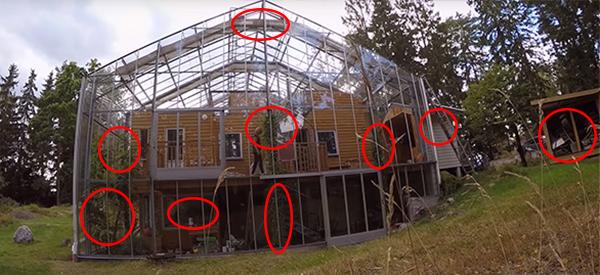














Novel approach…..Hope they buy Windex by the 55gal drum !
Not sure what 0.15 “security glass” is….not all that thick, bit over 1/8″. Guess it could be tempered glass which when broken shatters into thousand of tiny shards versus big cutting hunks from plate glass. Most larger glass here (like picture windows or glass doors) is 3/16″ (0.1875) or 1/4″ (0.25).
Thermal envelope houses aren’t new….the design for a inner house wrapped with a layer of passive solar heated air, using crawl space for a heat sink, then surrounded by outer shell, has been around since 1975. They could be built far more cheaply than surrounding an entire house with glass.
But there are many ways to skin a cat……..
Still rather neat do not know if I would do this. If he would use leaded glass he would have a faraday cage.
How long does it take to wash all of those windows, and who is going to do it?
This might not be all it’s cracked up to be!
It’s an interesting concept, and very cool looking, but my first thought was “What would happen if there was a hail storm? Or really high winds? And would the glass roof support the kinds of snowfall common in that part of the world?”
To me, a far more practical option would be to insulate the existing structure and maybe enclose the porch for a sunroom/traditional greenhouse set-up. But that’s just me.
“and be inspired by what is possible with a little bit of creative thinking!” AND a lot of money.
Near the ranch I worked for in Colorado, a man built something like this. Double wall geodesic design with insulation pellets for shade. At night, after blowing insulation between glass panels, the house glowed. 2 stories, lots of floor space, gardens and a small waterfall. I don’t remember the costs, but framing was a lot less than a conventional. It was the rest of the costs that nearly drove him to the poor house. But a cool place.
Heaven forbid!!! January temps can be below 32 degrees. That would be northern Texas temps. I thought Sweden was cold.
I THINK THEY MEANT -32* THAT’S MINUS 32 DEGREES, OR 32 DEGREES BELOW 0
Invest your money wisely to avoid future unexpected expenditures. Building Inspection Sydney is a property inspection firm. A team of experts to help you find construction defects and pests in a timely manner when buying or selling residential property throughout Sydney. Save your budget and time on fixing mistakes during construction.